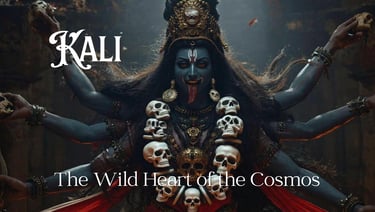Who Is Kali?
In the midnight folds of creation, where time dissolves and ego melts like wax beneath a burning flame, a goddess dances. She wears a necklace of skulls, her tongue blood-red, her laughter the sound of boundaries breaking. She is Kali, the wild, wondrous force behind death, rebirth, and liberation.
She is not here to be gentle. She is here to burn away illusions.


Kali (pronounced KAH-lee) is one of the most powerful and mysterious deities in the Hindu pantheon. She is a goddess of death and destruction, yes—but only of that which is false, stagnant, or binding. She destroys to protect. She ends to liberate. She is the storm that makes way for sunlight, the fire that purifies, the night before the dawn.
Often depicted with four arms, dark blue or black skin, and a wild crown of hair, Kali stands on the chest of her consort Shiva, reminding us that even destruction has a sacred place in the balance of life. Around her neck is a garland of severed heads—each one a symbol of an ego, a fear, a lie we've outgrown.
Her name means "Time" (Kala)—for Kali devours time itself. She reminds us that everything in this world is temporary, except for truth and love.
Symbols and Sacred Offerings
Sword or Sickle – To cut through illusion and ego
Skulls and Bones – Symbolizing transformation and impermanence
Red Hibiscus Flowers – Her favorite offering, fiery and alive
Flames and Ashes – The sacred cycle of destruction and rebirth
Dark Blue or Black – The color of her cosmic void
Charnel Grounds – Her sacred space, where death becomes a doorway
Despite her fierce form, Kali is deeply loving to those who seek truth. Her devotees don’t fear her—they dance with her.
The Legend: Kali and the Demon Raktabija
Long ago, in a world trembling under the weight of darkness, a terrible demon named Raktabija rose to power. For every drop of his blood that touched the earth, a new copy of him sprang up. No army, no god, no weapon could stop the multiplying terror.
The gods prayed to Durga, the warrior goddess, who, in her wrath and love, transformed into Kali—a storm of wild, divine fire.
Kali roared onto the battlefield, her eyes blazing like stars in eclipse. With each step, the earth quaked. With each laugh, demons fell. But here was her wisdom: Kali did not strike Raktabija with weapons alone. She drank his blood before it could touch the ground, catching each drop with her tongue. One by one, she devoured his duplicates until none remained.
But Kali, in her full power, could not stop. The dance of destruction continued—so fierce, so unstoppable—that the gods feared the world might end. Shiva, her beloved, lay himself beneath her feet. When Kali stepped upon him, she paused. Recognizing the one who balanced her wildness, she calmed. Her tongue slipped back into her mouth. Her fire softened. The world, reborn, exhaled.
How to Walk with Kali
Kali is not for the faint of heart—but she is for the true of soul. If you seek to break cycles, cut cords, and rise from your own ashes, she is waiting.
Call on her during the New Moon or eclipse seasons
Chant her mantra: "Om Krim Kalikaye Namaha"
Keep a small altar with black stones, red flowers, and symbols of death and rebirth
Journal with the question: "What must I release to be truly free?"
Final Blessing from the Black Mother
“I am not the end.
I am the truth behind the end.
I am the fire that frees you,
The void that loves you,
The night in which your soul is reborn.”


